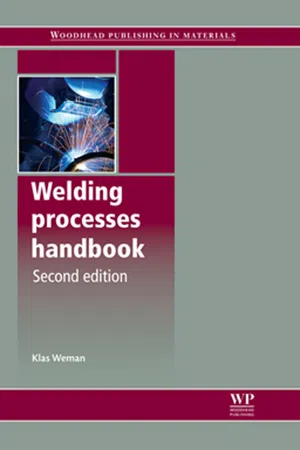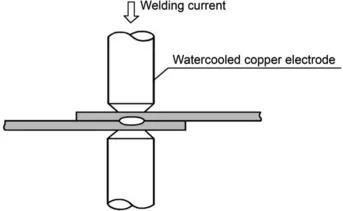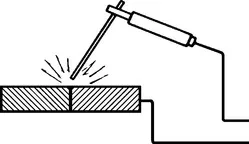
- 280 pages
- English
- ePUB (mobile friendly)
- Available on iOS & Android
Welding Processes Handbook
About this book
The first edition of Welding processes handbook established itself as a standard introduction and guide to the main welding technologies and their applications. This new edition has been substantially revised and extended to reflect the latest developments.After an initial introduction, the book first reviews gas welding before discussing the fundamentals of arc welding, including arc physics and power sources. It then discusses the range of arc welding techniques including TIG, plasma, MIG/MAG, MMA and submerged arc welding. Further chapters cover a range of other important welding technologies such as resistance and laser welding, as well as the use of welding techniques for cutting, surface cladding and hardfacing, soldering and brazing. A final group of chapters discuss more general issues such as mechanisation, safety, residual stress and distortion, welding design, costs and quality assurance, as well as the welding of steel and aluminium.The new edition of Welding processes handbook confirms its reputation as a concise, authoritative and practical introduction to welding and its applications for both students and engineers. It is designed to meet the requirements of Module 1: Welding processes and equipment of the International Institute of Welding (IIW) guidelines for the training of welding personnel at IWE, IWT, IWS and IWP level.- This new edition has been substantially revised and extended to reflect the latest developments in the main welding technologies and their applications- Reviews gas welding and discusses the fundamentals of arc welding, including arc physics and power sources, before covering the range of arc welding techniques, including TIG, plasma, MIG/MAG, MMA and submerged arc welding- Examines a range of important welding technologies, such as resistance and laser welding and the use of welding techniques for cutting, surface cladding and hardfacing, soldering and brazing
Frequently asked questions
- Essential is ideal for learners and professionals who enjoy exploring a wide range of subjects. Access the Essential Library with 800,000+ trusted titles and best-sellers across business, personal growth, and the humanities. Includes unlimited reading time and Standard Read Aloud voice.
- Complete: Perfect for advanced learners and researchers needing full, unrestricted access. Unlock 1.4M+ books across hundreds of subjects, including academic and specialized titles. The Complete Plan also includes advanced features like Premium Read Aloud and Research Assistant.
Please note we cannot support devices running on iOS 13 and Android 7 or earlier. Learn more about using the app.
Information
Introduction to welding
1.1 The history of welding

Resistance welding

Gas welding

Arc welding

Table of contents
- Cover image
- Title page
- Table of Contents
- Copyright
- Preface
- Chapter 1: Introduction to welding
- Chapter 2: Gas welding
- Chapter 3: Basics of electricity in welding
- Chapter 4: Arc welding: an overview
- Chapter 5: Power sources for arc welding
- Chapter 6: TIG welding
- Chapter 7: Plasma welding
- Chapter 8: MIG/MAG welding
- Chapter 9: Manual metal arc (MMA) welding with coated electrodes
- Chapter 10: Submerged arc welding
- Chapter 11: Pressure welding methods
- Chapter 12: Other methods of welding
- Chapter 13: Cutting methods
- Chapter 14: Surface cladding and hardfacing methods
- Chapter 15: Mechanisation and robot welding
- Chapter 16: Soldering and brazing
- Chapter 17: The welding environment and welding safety
- Chapter 18: Welding residual stress and distortion
- Chapter 19: The weldability of steel
- Chapter 20: Welding of aluminium
- Chapter 21: Design of welded components
- Chapter 22: Quality assurance and quality management
- Chapter 23: Welding costs
- Index